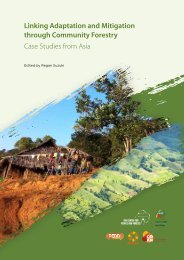Desktop Study on - Regional Climate Change Adaptation ...
Desktop Study on - Regional Climate Change Adaptation ...
Desktop Study on - Regional Climate Change Adaptation ...
Create successful ePaper yourself
Turn your PDF publications into a flip-book with our unique Google optimized e-Paper software.
<str<strong>on</strong>g>Desktop</str<strong>on</strong>g> <str<strong>on</strong>g>Study</str<strong>on</strong>g><br />
climate change impacts <strong>on</strong> the natural ecosystems<br />
(UNDP and WREA, 2009). Effectively, Lao PDR’s<br />
socio-ec<strong>on</strong>omic development has seen significant<br />
adverse effects due to climatic extreme event such as<br />
floods and drought occurring in past years (Lao PDR,<br />
2009a). Especially, the agricultural sector, being<br />
affected by climate change, is a major c<strong>on</strong>tributor<br />
to the ec<strong>on</strong>omy of Lao PDR and the livelihood of<br />
its people. Besides the income, employment, and<br />
food security affected, water and forestry resources<br />
as well as public health are other socio-ec<strong>on</strong>omic<br />
aspects are influenced by climate change. Indeed,<br />
climate change seems to cause an exacerbati<strong>on</strong> of<br />
already existing man-made envir<strong>on</strong>mental risks<br />
such as envir<strong>on</strong>mental degradati<strong>on</strong> as well as of<br />
natural disasters (Lao PDR, 2009a).<br />
Also, socio-ec<strong>on</strong>omic c<strong>on</strong>diti<strong>on</strong>s and food insecurity<br />
of Lao’s rural populati<strong>on</strong> appear to be str<strong>on</strong>gly<br />
related: According to the WFP-study (2007) <strong>on</strong> Lao<br />
PDR’s food security situati<strong>on</strong>, people affected by<br />
food insecurity tend to be farmers that are lowly<br />
educated, illiterate, from n<strong>on</strong>-Lao-Thai ethnic<br />
groups, practicing farming in upland and highly<br />
sloped areas, and living in villages with poor sanitary<br />
and infrastructural c<strong>on</strong>diti<strong>on</strong>s.<br />
Adaptati<strong>on</strong><br />
In the Lao Province of Attapeu, a vulnerability<br />
assessment of climate risks was carried out under<br />
the Mek<strong>on</strong>g Wetlands Biodiversity C<strong>on</strong>servati<strong>on</strong><br />
and Sustainable Use Programme in 2005 (ADPC,<br />
2005). The study recommended enhanced livelihood<br />
opti<strong>on</strong>s to being less vulnerable to severe flooding<br />
and droughts. Opti<strong>on</strong>s to diversify activities in an<br />
agrarian ec<strong>on</strong>omy include agro-processing, eco-/<br />
agro-tourism, and the promoti<strong>on</strong> of traditi<strong>on</strong>al<br />
handicrafts. The availability of credit systems for<br />
village communities is proposed as another opti<strong>on</strong><br />
for supporting sustainable livelihoods (ADPC, 2005).<br />
A study <strong>on</strong> local coping mechanisms in disaster<br />
management has been published in 2002, focusing<br />
<strong>on</strong> how rural poor in Laos are applying coping<br />
mechanisms in resp<strong>on</strong>se to shocks to their livelihoods<br />
caused by disasters (Brahmi and Poumph<strong>on</strong>e, 2002).<br />
The study revealed that there is a c<strong>on</strong>siderable gap<br />
between the percepti<strong>on</strong> of the government and most<br />
development practiti<strong>on</strong>ers, <strong>on</strong> the <strong>on</strong>e hand, and the<br />
percepti<strong>on</strong> of the poor populati<strong>on</strong>, <strong>on</strong> the other hand,<br />
with respect to the definiti<strong>on</strong> of a `disaster´. The<br />
latter can be distinguished between a `big disaster´<br />
and `<strong>on</strong>going disasters´. The investigati<strong>on</strong> revealed<br />
that recurrent seas<strong>on</strong>al human diseases c<strong>on</strong>stitute<br />
the greatest threat to the people’s livelihoods, since<br />
human labour c<strong>on</strong>stitutes the essential resource<br />
for the provisi<strong>on</strong> of food through hunting, fishing,<br />
and agriculture. In the case of illness, the level of<br />
subsistence cannot be sustained besides disasters<br />
bring varying degree of coping scope. Also, the<br />
study shows that currently <strong>on</strong>going ec<strong>on</strong>omic,<br />
socio-cultural and envir<strong>on</strong>mental changes in Laos<br />
significantly impact the indigenous coping capacity<br />
of the poor’s’ livelihoods. The critical changes include<br />
rapid populati<strong>on</strong> growth, expansi<strong>on</strong> of the market<br />
ec<strong>on</strong>omy, and the relocati<strong>on</strong> of communities from<br />
forested mountains to valleys, which leads to the<br />
incapacity of populati<strong>on</strong>s to adapt the food producti<strong>on</strong><br />
to unfamiliar envir<strong>on</strong>ment and market c<strong>on</strong>diti<strong>on</strong>s,<br />
and to withstand lowland diseases and climatic<br />
c<strong>on</strong>diti<strong>on</strong>s. The access to market, for instance, seems<br />
to have affected the use of kinship and solidarity<br />
as coping mechanisms in the case of disasters.<br />
The recommendati<strong>on</strong> formulated in the study is<br />
that disaster management must be mainstreamed<br />
into rural development programming. According<br />
to the study, there is already some evidence that<br />
disaster management programs in Laos are already<br />
increasingly focusing <strong>on</strong> addressing the causes of the<br />
populati<strong>on</strong>’s vulnerability to disasters for mitigating<br />
their effects (Brahmi and Poumph<strong>on</strong>e, 2002).<br />
Instituti<strong>on</strong>al Resp<strong>on</strong>ses<br />
Poverty reducti<strong>on</strong> is a key goal of the Lao PDR<br />
government and c<strong>on</strong>stitutes the basis for the<br />
Government policies formulated in the Nati<strong>on</strong>al<br />
Growth and Poverty Eradicati<strong>on</strong> Strategy (NGPES) in<br />
2003, aiming at overcoming Lao PDR’s status of a LDC<br />
by 2020 (Lao PDR, 2009a). Also, thanks to educati<strong>on</strong><br />
development plans, progress in the educati<strong>on</strong> level<br />
of the populati<strong>on</strong> could be achieved, with the adult<br />
literacy rate rising from 73% in 2005 to 77% in<br />
2007. Overall, Lao PDR has improved its positi<strong>on</strong> in<br />
the Human Development Index of the United Nati<strong>on</strong>s<br />
from rank 141 (out of 173) in 1993 to the rank 133<br />
(out of 179) in 2009 (Lao PDR, 2009a).<br />
In 2006, the Sixth Nati<strong>on</strong>al Socio-Ec<strong>on</strong>omic<br />
Development Plan (NSEDP) 2006-2010 was<br />
published (Lao PDR, 2006). This Plan aims at<br />
supporting the achievement of the goals that<br />
were outlined in the Ten-Year Socio-Ec<strong>on</strong>omic<br />
Development Strategy (2001-2010), including the<br />
establishment of a fast and stable development. The<br />
Plan’s targets and indicators mostly coincide with<br />
the Millennium Development Goals (MDGs) and the<br />
Brussels Programme of Acti<strong>on</strong> for Least Developed<br />
countries (2001-2010) (Lao PDR, 2006). It has to be<br />
noted, however, that the NSEDP does not address the<br />
threat posed through climate change to the country’s<br />
development.<br />
24

















